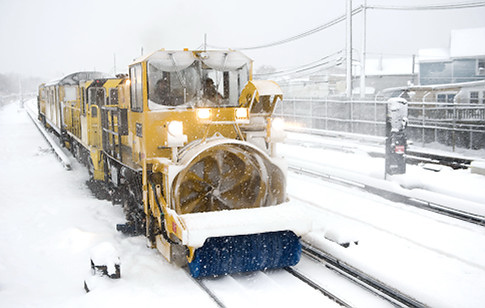 New York City – As swirling snow shrouded eastern Queens, a yellow-and-black diesel train rumbled on the A subway line towards the Rockaways, lights flashing, sirens sounding.
New York City – As swirling snow shrouded eastern Queens, a yellow-and-black diesel train rumbled on the A subway line towards the Rockaways, lights flashing, sirens sounding.
Subscribe to our Daily Roundup Email
It was the peak of the near-blizzard.
Snow drifts threatened to force suspension of subway service to the peninsula. And NYC Transit had called in the artillery.
“It’s like your household snow blower but a million times bigger,” agency engineer Edward Macina said late Wednesday as the five-car diesel train chugged past the silent expanse of Kennedy Airport.
The train is a key component in the agency’s comprehensive snow-battle plan.
A six-foot cylindrical brush attached to the front sweeps snow into an even wider metal tube.
Snow is then blasted away — far away — from the rails from the mouth of a chute about eight feet in the air.
The machine can launch the snow 200 feet, removing 3,000 tons of snow an hour. Macina, project manager in the car equipment department, joked ‘Snow Eater’ might be an appropriate nickname.
The approximately five-mile segment of the A line between Howard Beach and the Rockaways may be the toughest to maintain service during a major winter storm.
It crosses through wide-open stretches of marsh and over the Jamaica Bay on a narrow band of elevated tracks.
Other drift-prone areas that require special attention are on the Dyre Ave. line in the Bronx, and the Sea Beach, Brighton and Culver lines in Brooklyn.
Drifts can trip a subway train’s emergency brakes or damage an engine. Ice on the third-rail can cut off power and jam switches. To keep the subways moving Wednesday, NYC Transit at times had about 60 work trains scraping rails and dispensing de-icer.
Hundreds of track workers were also deployed around the system to dig out frozen or faulty equipment along lines and in yards. It may be called the subway, but there’s still nearly 220 miles of outdoor track.
“It’s grueling work, particularly in the Rockaways, where you are completely exposed to the elements,” said John Samuelsen, a track worker recently elected president of Transport Workers Union Local 100.
“There’s very few places to find any cover. Think about shoveling your driveway. These guys are doing it for eight to 12 hours straight.”
Subway ridership was lighter than usual Wednesday, but NYC Transit ran its regular schedule.
“Steel on steel keeps the snow from building up and the trains running,” John McGuinness, assistant chief transportation officer, said.
The night before the snow storm began, NYC Transit parked thousands of its subway cars in tunnels to protect them from the elements.
Extra police patrolled the underground to watch for vandals seeing an opportunity. The trains normally are parked in yards ringed with barbed-wire and flood lights.
Turning underground express tracks into subway train garages also meant car cleaners on the overnight shift were shuttled to a lay-up area.
Motorman and conductors assigned to the morning rush hour had to report early so they could do their pre-shift inspections in the lay-ups.
“The subway is like the mailman used to be – through rain, sleet, snow – the trains must run to safely deliver people, including the mailman, to their destinations,” NYC Transit deputy superintendent Tim Birnstill said.

For 2.25 a fare they should be able to plow some snow away once in three years.
For 2.25 a fare , you are at least getting your money’s worth .
For those of you who complain about paying taxes: this is what your taxes go for. If you don’t pay, you don’t play. No clear tracks, no clean water, no fixing streets – ever. Maybe it’s not all you want instantaneously, but what is? Would you expect the mechanic to fix your car for free?
And show some appreciation for those guys who are out there in the blizzard making sure you can get to work in the morning. Sure, they’re “only doing their job” – but could YOU do it?
The fair market value of the fare on the subway system is about $6 /$7 and that’s what rider’s should pay. Shifting the cost to taxpayers, utility consumers, drivers etc. is an unfair tax and the method politicians use to buy votes.
First of all you have to pay taxes! It is those of us who work and receive paychecks and not cash under the table who bear the brunt of the tax burden!
I give these guys a lot of credit for doing this – not only do they have to keep the tracks clean, but they also have to de-ice the third rail (which stays energized during snow storms) and use torches to unfreeze the switches.
#9 – just of out curiosity, do you work? Do you actually pay taxes? Or are you living off your shver?
don’t mind paying taxes. issue is everythng is taxed. and taxes keeping on going up as well more things are being taxed
I was on the A train during blizzard, and B”H it ran and didn’t get stuck. In a previous storm, an LIRR train got stuck for 6 hours overnite.
They should send some of these snow clearing trains down to Washington D.C. All the above ground stations were closed for 5 days after the big snow. Their rules require them to close the system after 8 inches of snowfall and they have no ability to clear the tracks and third rail of a heavy snow.